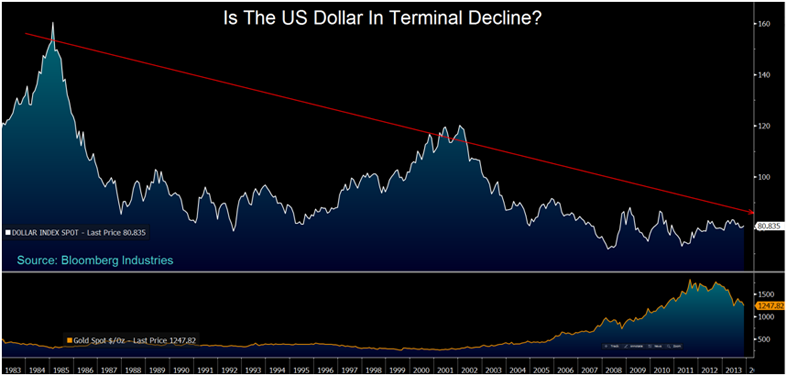“I cannot look at myself in the mirror; everything I have believed in I have had to reject. This environment only makes sense through the prism of trends.”
– Hugh Hendry
First David Rosenberg, now Hugh Hendry: one after another the bears are throwing in the towel.
As Investment Week reports, speaking at Harrington Cooper’s 2013 conference this morning, Hugh Hendry said “he is no longer fighting the two-way feedback loop which is continuing to boost risk assets.” The reflexive feedback loop envisioned by Hendry is the following and centres on the currency war being played out between the US and China, “in which US QE prompts dollar-denominated investment to head to China, and China fights the resulting upwards pressure on its currency by manufacturing an investment boom. Hendry said this creates a “global supply glut”, leading to falling US inflation expectations (as this supply far outweights US domestic demand) – which in turn prompts the Federal Reserve to loosen policy once again.” Rinse. Repeat.
Of course, there is a limitation here as we have explained previously, namely the amount of “high-quality collateral” which the Fed and the other central banks can and are rapidly soaking up, in the process destroying bond market liquidity, but that “discovery” will be made by the Fed far too late, despite even the repeated warnings of the Treasury Borrowing Advisory Committee.
And since Hendry is constrained by daily, monthly and annual P&L, he simply does not have luxury of waiting for the “fat tail” event, which incidentally will be quite terminal and thus hardly profitable for anyone exposed to fiat-denominated assets.
So the end result is that Hugh Hendry is merely the latest bear to throw in the towel:
“I can no longer say I am bearish. When markets become parabolic, the people who exist within them are trend followers, because the guys who are qualitative have got taken out,” Hendry said.
“I have been prepared to underperform for the fun of being proved right when markets crash. But that could be in three-and-a-half-years’ time.”
“I cannot look at myself in the mirror; everything I have believed in I have had to reject. This environment only makes sense through the prism of trends.”
So what does the newly christened “bull” like?
Though he first began turning more positive on the likes of US and Japanese equities last year, Hendry suggested this morning the current environment created more counter-intuitive opportunities. “This applies to European banks, Greek equities, Spanish equities. You have got to be in things that are trending,” he said.
The manager’s Eclectica Absolute Macro fund had a 64% value at risk equity allocation in September, up from 45% in August, with December 2013 Japanese TOPIX index futures his biggest single holding on a VaR basis.
Addressing attendees this morning, Hendry said his comments would take on a “confessional” tone, and admitted his performance over the past year had been “at best, mediocre”. Hendry’s CF Eclectica Absolute Macro fund has lost 2.6% in the nine months to 30 September, according to the firm.
In other words the “dash for trash” mentality, which we predicted in September 2012 when we forecast that the most shorted stocks would outperform the market (and they have), has just won another convert. That, and of course, Fed-balance sheet induced momentum chasing, in which the only thing that matters is one’s view how many “assets” the Fed will hold at any point in the future (see from April: “Bernanke & Kuroda Capital LLC: Overweight S&P 500, 2013 Target 1950“).
Finally, Hendry’s “come to Bernanke” moment does not come easily:
The manager acknowledged his changing stance may be viewed by some investors as a ‘top of the market’ signal, but said he is not concerned by the prospect of a crash.
“I may be providing a public utility here, as the last bear to capitulate. You are well within your rights to say ‘sell’. The S&P 500 is up 30% over the past year: I wish I had thought this last year.”
“Crashing is the least of my concerns. I can deal with that, but I cannot risk my reputation because we are in this virtuous loop where the market is trending.”
Sadly, his last statement is just the latest confirmation that in the New Centrally-Planned Normal, FOMO or Fear of Missing Out (the trend, the year end bonus, you name it) is indeed the new POMO as we warned in May.
And like that, everyone is now on the same side of the boat.
![]()
via Zero Hedge http://feedproxy.google.com/~r/zerohedge/feed/~3/2VGgVDEKqNQ/story01.htm Tyler Durden



















